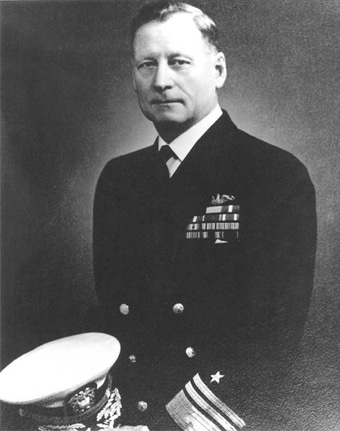USS Paul F. Foster Association
Vice Admiral Paul Frederick Foster
Born March 25, 1889
About Vice Admiral Paul Frederick Foster
Paul Frederick Foster was born on March 25, 1889 in Wichita, Kansas. He received a senatorial appointment from the State of Idaho to the U.S. Naval Academy.
Following graduation in 1911, he served in the armored cruiser Washington and the battleship Utah as a midshipman and, in March 1912, was commissioned as an Ensign. On 21-22 April 1914, Foster participated at the intervention at Vera Cruz, Mexico, leading his landing company with skill and courage. For his “distinguished conduct in battle”, he was awarded the Medal of Honor. After submarine instruction on board USS Prairie, he reported on board USS G-4. In March 1915, Foster was promoted to Lieutenant Junior Grade and, in early 1916, was placed in command of G-4. Relocating to Ireland in December 1917, he was assigned to the submarine tender Bushnell in Bantry Bay, Ireland. Foster was temporarily promoted to Lieutenant in May 1918. While serving in Irish waters, he took command of the submarine L-2. Lieutenant Foster was awarded the Distinguished Service Medal for his role in the sinking of the German submarine UB-65 off the Irish coast on 10 July 1918.
Foster received a temporary promotion to Lieutenant Commander and had shore duty as a Tactical Instructor with Submarine Division 2 at New London, Connecticut. In June 1920, he was briefly assigned to the new battleship Tennessee, then transferred to the minelayer San Francisco for six months as her Executive Officer. In July 1921, Foster reported for duty as the Officer in Charge of the Navy Recruiting Bureau in New York City. As the principal Navy liaison with the city’s newspapers and magazines, he organized the first Navy radio programs and newreels. In December 1921, he was permantly promoted to Lieutenant Commander. In early 1924, he became the Engineering Officer of the new light cruiser Trenton. On 20 October 1924, Foster saved lives of several crewmen when one of the ship’s turrets exploded and caught fire. For his “extraordinary heroism” in that incident, he was awarded the Navy Cross. Lieutenant Commander Foster thus became the first person to receive all three of the Navy’s highest awards. In July 1927, he returned to New York City for service with the Third Naval District, and in March 1929, resigned from the regular Navy and entered the Naval Reserve.
Recalled to active duty during World War II, Foster was promoted to Captain and assigned to the Logistics Plans Division of the Office of the Chief of Naval Operations. He was later the Assistant Naval Inspector General and a member of the Navy Manpower Survey Board. He retired with the rank of Vice Admiral in December 1946. After some time in the private sector, Foster joined the Atomic Energy Commission in June 1954 as a special assistant, becoming its General Manager four years later. In 1959, President Dwight D. Eisenhower appointed him to the International Atomic Energy Agency, in Vienna, Austria, with the rank of Ambassador, and he served in that position until 1961. Paul F. Foster died on 30 January 1972 at Virginia Beach, Virginia and is buried at Arlington National Cemetery, Virginia.

